Quebec City
Québec | |
|---|---|
| Ville de Québec(French) | |
|
| |
| Nicknames: | |
| Motto(s): Don de Dieu feray valoir ( "I shall put God's gift to good use"; theDon de Dieuwas Champlain's ship) | |
 Quebec City map | |
| Coordinates:46°48′50″N71°12′29″W/ 46.81389°N 71.20806°W[2][3] | |
| Country | Canada |
| Province | Quebec |
| Region | Capitale-Nationale |
| Metropolitan community | Communauté métropolitaine de Québec |
| Agglomeration | Agglomeration of Quebec City |
| Historic countries | Kingdom of France Kingdom of Great Britain |
| First settled | 11 October 1535, byJacques Cartier |
| Founded | 3 July 1608, bySamuel de Champlain |
| Constituted | 1 January 2002 |
| Incorporated | 1832[4] |
| Boroughs | |
| Government | |
| • Type | Quebec City Council |
| • Mayor | Bruno Marchand |
| •MPs | List of MPs |
| •MNAs | List |
| Area | |
| •City | 452.30 km2(174.63 sq mi) |
| • Land | 453.38 km2(175.05 sq mi) |
| • Urban | 442.85 km2(170.99 sq mi) |
| • Metro | 3,499.46 km2(1,351.15 sq mi) |
| Elevation | 98 m (322 ft) |
| Population (2021)[6] | |
| •City | 549,459 (12th) |
| • Density | 1,214.8/km2(3,146/sq mi) |
| •Urban | 733,156 (8th) |
| • Urban density | 1,655.5/km2(4,288/sq mi) |
| •Metro | 839,311 (7th) |
| • Metro density | 239.8/km2(621/sq mi) |
| • Pop2016–2021 | |
| Demonym | Québécois or Québécois de Québec (to distinguish residents of the city from those of the province) |
| Time zone | UTC−05:00(EST) |
| • Summer (DST) | UTC−04:00(EDT) |
| Postal codes | |
| Area codes |
|
| GDP(QuébecCMA) | CA$47.94 billion (2020)[9] |
| GDP per capita (QuébecCMA) | CA$53,477 (2016) |
| Website | ville |
| Official name | Historic District of Old Quebec |
| Type | Cultural |
| Criteria | iv, vi |
| Designated | 1985(9thsession) |
| Reference no. | 300 |
| Region | Europe and North America |
Quebec City(/kwɪˈbɛk/or/kəˈbɛk/;[11]French:Ville de Québec), officiallyQuébec(French pronunciation:[kebɛk]),[12]is the capital city of theCanadian provinceofQuebec.As of July 2021, the city had a population of 549,459,[13]and themetropolitan areahad a population of 839,311.[14]It is the twelfth-largest cityand the seventh-largest metropolitan areain Canada. It is also thesecond-largest cityin the province, afterMontreal.It has ahumid continental climatewith warm summers coupled with cold and snowy winters.
ExplorerSamuel de Champlainfounded a French settlement here in 1608, and adopted the Algonquin name. Quebec City is one of theoldest European settlementsin North America. TherampartssurroundingOld Quebec(Vieux-Québec) are the only fortifiedcity wallsremaining in the Americas north ofMexico.This area was declared aWorld Heritage SitebyUNESCOin 1985 as the "Historic District of Old Québec".[15][16]
Name and usage
[edit]CommonEnglish-languageusage distinguishes the city from the province by referring to the former as Quebec City.[17]
According to the Government of Canada, the Government of Quebec, and the Geographical Names Board of Canada, the names of Canadian cities and towns have only one official form. Thus, Québec is officially spelled with an accented é in bothCanadian EnglishandFrench.[18][19][20]However, province names can have different forms in English and French. As a result, in English, the federal government style distinguishes the city and province by spelling the city with an acute accent (Québec) and the province without one (Quebec). The government of Quebec spells both names "Québec", including when writing in English.[21]
In French, the two are distinguished in that province names including Quebec generally takedefinite articles,while city names do not. As a result, the city isQuébecand the province isle Québec;"in Quebec City" isà Québecand "in the province of Quebec" isau Québec;and so forth.[22]
TheAlgonquian peoplehad originally named the areaKébec,anAlgonquin[note 1]word meaning "where the river narrows", because theSaint Lawrence Rivernarrows proximate to thepromontory of Quebecand itsCape Diamant.
The city's landmarks include theChâteau Frontenachotel that dominates the skyline and theCitadelle of Quebec,an intact fortress that forms the centrepiece of the ramparts surrounding the old city and includes a secondaryroyal residence.TheNational Assembly of Quebec(provincial legislature), theMusée national des beaux-arts du Québec(National Museum of Fine Arts of Quebec), and theMusée de la civilisation(Museum of Civilization) are found within or near Vieux-Québec.
History
[edit]French regime (1500s–1763)
[edit]Quebec City is one of the oldest European settlements inNorth Americaand the only fortified city north ofMexicowhose walls still exist.[23]While many of the major cities inLatin Americadate from the 16th century, among cities in Canada and the United States, few were created earlier than Quebec City (St. John's,Harbour Grace,Port Royal,St. Augustine,Santa Fe,Jamestown,andTadoussac).

It is home to the earliest known French settlement in North America,Fort Charlesbourg-Royal,established in 1541 by explorerJacques Cartierwith some 400 persons but abandoned less than a year later due to the harsh winter and resistance of indigenous inhabitants to colonial incursion on their land.[24]The fort was at the mouth of theRivière du Cap Rouge,in the suburban formertown of Cap-Rouge(which merged into Quebec City in 2002).
Quebec was founded bySamuel de Champlain,a French explorer and diplomat, on 3 July 1608,[25][26]and at the site of a long abandonedSt. Lawrence Iroquoiansettlement calledStadacona.Champlain, who came to be called "The Father ofNew France",served as its administrator for the rest of his life.
Thename "Canada"was given to the colony that developed around the settlement at Quebec. Although theAcadiansettlement atPort-Royalwas established three years earlier, Quebec came to be known as the cradle of North America'sFrancophonepopulation. The location seemed favourable to the establishment of a permanent colony.
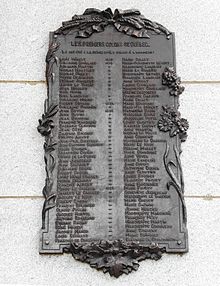
The population of the settlement remained small for decades. In 1629 it wascaptured by English privateers,led byDavid Kirke,during theAnglo-French War.[27]Samuel de Champlain argued that the English seizing of French lands was illegal as the war had already ended, and worked to have them returned to France. As part of the ongoing negotiations following the end of the Anglo-French War, in 1632 the English kingCharles Iagreed to return captured lands in exchange forLouis XIIIpaying his wife'sdowry.[27]These terms were signed into law with theTreaty of Saint-Germain-en-Laye.The colonies ofCanadaandAcadiawere returned to the FrenchCompany of One Hundred Associates.[27]
In 1665, there were 550 people in 70 houses living in the city. One-quarter of the people were members of religious orders: secular priests, Jesuits, Ursulines nuns and the order running the local hospital, Hôtel-Dieu.[28]
Quebec was the headquarters of many raids againstNew Englandduring theFrench and Indian Wars.In 1690 the citywas attacked by the English,but was successfully defended. In the last of the conflicts, theFrench and Indian War(Seven Years' War), Quebec was captured by the British in 1759, and held until the end of the war in 1763. In that time many battles and sieges took place: theBattle of Beauport,a French victory (31 July 1759); theBattle of the Plains of Abraham,in which British troops under GeneralJames Wolfedefeated the French GeneralLouis-Joseph de Montcalmon 13 September 1759, and shortly thereafter took the city after a short siege. A French counterattack saw a French victory at theBattle of Sainte-Foy(28 April 1760) but the subsequent secondSiege of Quebecthe following month however saw a final British victory.
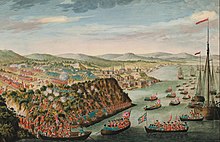
France cededNew France,including the city, to Britain in 1763,[29]when theFrench and Indian Warofficially ended.
At the end of French rule, Quebec was a town of 8,000 inhabitants, surrounded by forests, villages, fields and pastures. The town was distinguished by its monumental architecture, fortifications, and affluent homes of masonry and shacks in the suburbs of Saint-Jean and Saint-Roch. Despite its urbanity and its status as capital, Quebec remained a small city with close ties to its rural surroundings. Nearby inhabitants traded their farm surpluses and firewood for imported goods from France at the two city markets.
British and Canadian rule (1763–present)
[edit]This sectionneeds additional citations forverification.(April 2016) |

During theAmerican Revolution,revolutionary troops from the southern coloniesassaulted the British garrison in the cityin the hope that the peoples of Quebec would rise and join theAmerican Revolutionso that Canada would join theContinental Congress,along with the other British colonies of continental North America. The American invasion failed, however, and the war resulted in a permanent split of British North America into two entitles: the newly independentUnited States of America,and those colonies (including Quebec) that remained under British control, which would later become the country ofCanada.
The city itself was not attacked during theWar of 1812,when the United States again attempted to annex Canadian lands. Amid fears of another American attack on Quebec City, construction of theCitadelle of Quebecbegan in 1820. The Americans did not attack Canada after the War of 1812, but the Citadelle continued to house a large British garrison until 1871. It is still in use by the military and is also a tourist attraction.
Until the late 18th century Québec was the most populous city in present-day Canada. As of the census of 1790, Montreal surpassed it with 18,000 inhabitants, but Quebec (pop. 14,000) remained the administrative capital of the former New France.[30]It was then made the capital ofLower Canadaby theConstitutional Act of 1791.[31]From 1841 to 1867, the capital of theProvince of Canadarotated betweenKingston,Montreal,Toronto,Ottawaand Quebec City (from 1851 to 1855 and from 1859 to 1865).[32]
Before theRoyal Military College of Canadawas established in 1876, the only French-speaking officer training school was the Quebec City School of Military Instruction, founded in 1864.[33]The school was retained at Confederation, in 1867. In 1868, The School of Artillery was formed in Montreal.[34]

TheQuebec ConferenceonCanadian Confederationwas held in the city in 1864. In 1867,Queen Victoriachose Ottawa as the definite capital of the Dominion of Canada, while Quebec City was confirmed as the capital of the newly created province of Quebec.
During World War II, two conferences were held in Quebec City. TheFirst Quebec Conferencewas held in 1943 withFranklin D. Roosevelt(President of the United States),Winston Churchill(Prime Minister of the United Kingdom),William Lyon Mackenzie King(Prime Minister of Canada) andT. V. Soong(minister of foreign affairs ofChina). TheSecond Quebec Conferencewas held in 1944 and was attended by Churchill and Roosevelt. They took place in the buildings of the Citadelle and at the nearbyChâteau Frontenac.A large part of theD-Daylanding plans were made during those meetings.
Until 2002, Quebec was a mostly urbanized city and its territory coterminous with today's borough ofLa Cité-Limoilou.The Government of Quebec then mandated amunicipal reorganization in the province,and manysuburbsof the north shore of the Saint-Lawrence were merged into Quebec City, taking the form ofboroughs,thus constituting the boundary of present-day Québec City. In 2008 the city celebrated its400th anniversaryand was gifted funds for festivities and construction projects by provincial and federal governments, as well aspublic artworkby various entities, including foreign countries.
Geography
[edit]
Quebec City was built on the north bank of theSaint Lawrence River,where it narrows and meets the mouth of theSaint-Charles River.Old Quebecis located on top and at the foot ofCap-Diamant,which is on the eastern edge of aplateaucalled thepromontory of Quebec(Quebec hill). Because of this topographic feature, the oldest and most urbanized borough ofLa Cité-Limoiloucan be divided into upper and lower town.[35]North of the hill, theSaint Lawrence Lowlandsis flat and has rich, arable soil. Past this valley, theLaurentian Mountainslie to the north of the city but itsfoothillsare within the municipal limits.
ThePlains of Abrahamare located on the southeastern extremity of the plateau, wherehigh stone wallswere integrated during colonial days. On the northern foot of the promontory, the lower town neighbourhoods ofSaint-RochandSaint-Sauveur,traditionally working class,[36]are separated from uptown'sSaint-Jean-BaptisteandSaint-Sacrementby a woody area attested asCoteau Sainte-Geneviève.
The area was affected by the1925 Charlevoix–Kamouraska earthquake.
Theadministrative regionin which it is situated is officially referred to asCapitale-Nationale,[37][38]and the term "national capital" is used to refer to Quebec City itself at the provincial level.[39]
Climate
[edit]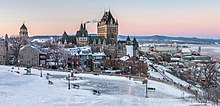
Quebec City is classified as ahumid continental climate(Köppen climate classificationDfb).[40]
Quebec City experiences four distinct seasons. Summers are warm and occasionally hot, with periods of hotter temperatures which compounded with the high humidity, create a high heat index that belies the average high of 22–25 °C (72–77 °F) and lows of 11–13 °C (52–55 °F). Winters are cold, windy and snowy with average high temperatures −5 to −8 °C (23 to 18 °F) and lows −13 to −18 °C (9 to 0 °F). Spring and fall, although short, bring chilly to warm temperatures. Late heat waves as well as "Indian summers"are a common occurrence.[citation needed]
On average, Quebec City receives 1,190 millimetres (46.85 in) of precipitation, of which 899 millimetres (35.39 in) is rain and 303 millimetres (11.93 in) is the melt from 316 centimetres (124.4 in) of snowfall per annum.[note 2]The city experiences around 1,916 hours of bright sunshine annually or 41.5% of possible sunshine, with summer being the sunniest, but also slightly the wettest season. During winter, snow generally stays on the ground from the end of November till mid-April.
The highest temperature ever recorded in Quebec City was 36.1 °C (97.0 °F) on 17 July 1953.[41]The coldest temperature ever recorded was −36.7 °C (−34.1 °F) on 10 January 1890 and 14 January 2015.[42][43]
| Climate data for Sainte-Foy, Quebec City (Québec City Jean Lesage International Airport) WMO ID:71708; coordinates46°48′N71°23′W/ 46.800°N 71.383°W;elevation: 74.4 m (244 ft); 1981–2010 normals, extremes 1875–present[note 3] | |||||||||||||
|---|---|---|---|---|---|---|---|---|---|---|---|---|---|
| Month | Jan | Feb | Mar | Apr | May | Jun | Jul | Aug | Sep | Oct | Nov | Dec | Year |
| Record highhumidex | 10.6 | 11.7 | 17.8 | 32.9 | 40.3 | 44.1 | 49.2 | 49.3 | 40.1 | 30.9 | 24.9 | 14.6 | 49.3 |
| Record high °C (°F) | 11.1 (52.0) |
11.7 (53.1) |
18.3 (64.9) |
29.9 (85.8) |
33.0 (91.4) |
34.4 (93.9) |
36.1 (97.0) |
35.6 (96.1) |
33.9 (93.0) |
28.3 (82.9) |
22.9 (73.2) |
15.0 (59.0) |
36.1 (97.0) |
| Mean daily maximum °C (°F) | −7.9 (17.8) |
−5.6 (21.9) |
0.2 (32.4) |
8.3 (46.9) |
17.0 (62.6) |
22.3 (72.1) |
25.0 (77.0) |
23.6 (74.5) |
17.9 (64.2) |
11.1 (52.0) |
2.9 (37.2) |
−4.2 (24.4) |
9.2 (48.6) |
| Daily mean °C (°F) | −12.8 (9.0) |
−10.6 (12.9) |
−4.6 (23.7) |
3.7 (38.7) |
11.2 (52.2) |
16.4 (61.5) |
19.3 (66.7) |
18.1 (64.6) |
12.7 (54.9) |
6.6 (43.9) |
−0.7 (30.7) |
−8.6 (16.5) |
4.2 (39.6) |
| Mean daily minimum °C (°F) | −17.7 (0.1) |
−15.6 (3.9) |
−9.4 (15.1) |
−1.0 (30.2) |
5.4 (41.7) |
10.5 (50.9) |
13.5 (56.3) |
12.5 (54.5) |
7.5 (45.5) |
2.0 (35.6) |
−4.2 (24.4) |
−12.8 (9.0) |
−0.8 (30.6) |
| Record low °C (°F) | −36.7 (−34.1) |
−36.1 (−33.0) |
−30.0 (−22.0) |
−18.9 (−2.0) |
−7.8 (18.0) |
−0.6 (30.9) |
3.9 (39.0) |
2.2 (36.0) |
−4.8 (23.4) |
−10.0 (14.0) |
−26.1 (−15.0) |
−35.6 (−32.1) |
−36.7 (−34.1) |
| Record lowwind chill | −51.1 | −52.4 | −41.0 | −29.0 | −13.6 | 0.0 | 0.0 | 0.0 | −7.8 | −17.3 | −30.8 | −48.4 | −52.4 |
| Averageprecipitationmm (inches) | 86.6 (3.41) |
74.5 (2.93) |
76.1 (3.00) |
83.5 (3.29) |
115.9 (4.56) |
111.4 (4.39) |
121.4 (4.78) |
104.2 (4.10) |
115.5 (4.55) |
98.3 (3.87) |
102.5 (4.04) |
99.9 (3.93) |
1,189.7 (46.84) |
| Average rainfall mm (inches) | 22.7 (0.89) |
15.2 (0.60) |
30.2 (1.19) |
67.5 (2.66) |
115.9 (4.56) |
111.4 (4.39) |
121.4 (4.78) |
104.2 (4.10) |
115.5 (4.55) |
94.6 (3.72) |
69.1 (2.72) |
31.7 (1.25) |
899.3 (35.41) |
| Average snowfall cm (inches) | 71.9 (28.3) |
63.6 (25.0) |
46.4 (18.3) |
13.2 (5.2) |
0.0 (0.0) |
0.0 (0.0) |
0.0 (0.0) |
0.0 (0.0) |
0.0 (0.0) |
3.2 (1.3) |
32.7 (12.9) |
72.4 (28.5) |
303.4 (119.4) |
| Average precipitation days(≥ 0.2 mm) | 17.1 | 14.3 | 13.4 | 12.1 | 15.4 | 13.4 | 13.5 | 13.4 | 13.4 | 14.4 | 16.0 | 18.5 | 174.9 |
| Average rainy days(≥ 0.2 mm) | 3.0 | 2.4 | 4.7 | 10.4 | 15.3 | 13.4 | 13.5 | 13.4 | 13.4 | 14.1 | 10.1 | 4.5 | 118.2 |
| Average snowy days(≥ 0.2 cm) | 16.3 | 13.2 | 10.5 | 4.3 | 0.13 | 0.0 | 0.0 | 0.0 | 0.0 | 1.0 | 8.1 | 16.6 | 70.1 |
| Averagerelative humidity(%)(at 3pm) | 67.8 | 64.6 | 60.7 | 55.9 | 51.6 | 56.0 | 59.1 | 59.1 | 61.8 | 63.1 | 70.4 | 73.2 | 61.9 |
| Mean monthlysunshine hours | 98.9 | 121.2 | 152.0 | 170.6 | 211.1 | 234.7 | 252.3 | 232.0 | 163.0 | 122.0 | 76.6 | 81.9 | 1,916.3 |
| Percentpossible sunshine | 35.5 | 41.8 | 41.3 | 41.9 | 45.3 | 49.6 | 52.7 | 52.7 | 43.1 | 36.0 | 27.1 | 30.7 | 41.5 |
| Averageultraviolet index | 1 | 2 | 3 | 4 | 6 | 7 | 7 | 6 | 5 | 3 | 1 | 1 | 4 |
| Source:Environment and Climate Change Canada,[44][45]extremes 1875–1959[46]and Weather Atlas[47] | |||||||||||||
Boroughs and neighbourhoods
[edit]This sectionneeds additional citations forverification.(April 2016) |
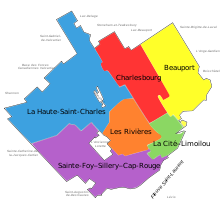
On 1 January 2002, the 12 former towns ofSainte-Foy,Beauport,Charlesbourg,Sillery,Loretteville,Val-Bélair,Cap-Rouge,Saint-Émile,Vanier,L'Ancienne-Lorette,Saint-Augustin-de-DesmauresandLac-Saint-Charleswere annexed by Quebec City. This was one of severalmunicipal mergerswhich took place across Quebec on that date. Following a demerger referendum, L'Ancienne-Lorette and Saint-Augustin-de-Desmaures were reconstituted as separate municipalities on 1 January 2006, but the other former municipalities remain part of Quebec City. On 1 November 2009, Quebec City re-organized its boroughs, reducing the number from 8 to 6.[48]
Quebec City's sixboroughs(French:arrondissements) are further divided into 35 neighbourhoods (French:quartiers).[49]In most cases, the name of the latter remained the same as the historicaltown(French:ville) orparish municipalityit replaced. Neighbourhoods each elect their own council, whose powers rest inpublic consultations.
Compared to many other cities in North America, there is less variation between average household incomes between the neighbourhoods. However, some disparities exist. The southwest former cities ofSillery,Cap-RougeandSainte-Foyare considered to be the wealthiest, along with some parts of Montcalm and Old Quebec.[citation needed]
The city's traditional working-class areas are found in the lower town below Old Quebec (Saint-Sauveur and Saint-Roch) and directly across theSaint-Charles Riverto the north (Vanier and Limoilou). However, parts of Limoilou, Saint-Sauveur and particularly Saint-Roch have seengentrificationin the last 20 years, attracting young professionals and the construction of new offices and condos.[50]
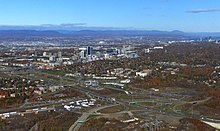
Northern sections (Loretteville, Val-Bélair) and eastern sections (Beauport, Charlesbourg) are mostly a mix of middle-class residential suburbs with industrial pockets.
| Boroughs | Neighbourhoods |
| 1La Cité-Limoilou | La Cité:1-1Vieux-Québec–Cap-Blanc–colline Parlementaire· 1-2Saint-Roch· 1-3Saint-Jean-Baptiste· 1-4Montcalm· 1-5Saint-Sauveur· 1-6Saint-Sacrement·Limoilou:6-1Vieux-Limoilou· 6-2Lairet· 6-3Maizerets |
| 2Les Rivières | 2-1Neufchâtel-Est–Lebourgneuf· 2-2Duberger-Les Saules· 2-3Vanier |
| 3Sainte-Foy–Sillery–Cap-Rouge | 3-1Sillery· 3-2Cité universitaire· 3-3Saint-Louis· 3-4Plateau· 3-5Pointe-de-Ste-Foy8-2 ·L'Aéroport· 8-3Cap-Rouge |
| 4Charlesbourg | 4-1Notre-Dame-des-Laurentides· 4-2 Quartier 4-2 · 4-3 Quartier 4-3 · 4-4Jésuites, Quebec City· 4-5 Quartier 4-5 · 4-6 Quartier 4-6 |
| 5Beauport | 5-1 Quartier 5-1 · 5-2 Quartier 5-2 · 5-3Chutes-Montmorency· 5-4 Quartier 5-4 · 5-5Vieux-Moulin |
| 7La Haute-Saint-Charles | 7-1Lac-Saint-Charles· 7-2Saint-Émile· 7-3Loretteville· 7-4Des Châtels· 8-1Val-Bélair |
Demographics
[edit]This sectionneeds additional citations forverification.(April 2016) |
| Year | Pop. | ±% |
|---|---|---|
| 1665 | 547 | — |
| 1667 | 444 | −18.8% |
| 1681 | 1,345 | +202.9% |
| 1685 | 1,205 | −10.4% |
| 1688 | 1,407 | +16.8% |
| 1692 | 1,570 | +11.6% |
| 1695 | 1,549 | −1.3% |
| 1698 | 1,988 | +28.3% |
| 1706 | 1,771 | −10.9% |
| 1739 | 4,603 | +159.9% |
| 1754 | 8,001 | +73.8% |
| 1765 | 8,967 | +12.1% |
| 1790 | 14,000 | +56.1% |
| 1825 | 22,101 | +57.9% |
| 1851 | 42,052 | +90.3% |
| 1861 | 51,109 | +21.5% |
| 1871 | 59,699 | +16.8% |
| 1881 | 62,446 | +4.6% |
| 1891a | 63,090 | +1.0% |
| 1901 | 68,940 | +9.3% |
| 1911b | 78,118 | +13.3% |
| 1921c | 95,193 | +21.9% |
| 1931 | 130,594 | +37.2% |
| 1941 | 150,757 | +15.4% |
| 1951 | 164,016 | +8.8% |
| 1956 | 170,703 | +4.1% |
| 1961 | 171,979 | +0.7% |
| 1966 | 166,984 | −2.9% |
| 1971d | 186,088 | +11.4% |
| 1976e | 177,082 | −4.8% |
| 1981 | 165,968 | −6.3% |
| 1986 | 164,580 | −0.8% |
| 1991 | 167,517 | +1.8% |
| 1996 | 167,264 | −0.2% |
| 2001 | 169,076 | +1.1% |
| 2006f | 491,142 | +190.5% |
| 2011 | 516,622 | +5.2% |
| 2016 | 531,902 | +3.0% |
| 2021 | 549,459 | +3.3% |
aQuebec City annexed the Village of Saint-Sauveur-de-Québec bQuebec City annexed the Town of Limoilou and the Village of Saint-Malo cQuebec City annexed the Town of Montcalm dQuebec City annexed the Town of Duberger and the Town of Les Saules eQuebec City annexed the Town of Neufchâtel and the Municipality of Charlesbourg-Ouest fQuebec City annexed the cities of Beauport, Cap-Rouge, Charlesbourg, Lac-Saint-Charles, Loretteville, Saint-Émile, Sainte-Foy, Sillery, Val-Bélair and Vanier | ||
| Year | Pop. | ±% |
|---|---|---|
| 1871 | 76,593 | — |
| 1881 | 80,249 | +4.8% |
| 1891 | 80,546 | +0.4% |
| 1901 | 88,615 | +10.0% |
| 1911 | 102,214 | +15.3% |
| 1921 | 122,698 | +20.0% |
| 1931 | 168,249 | +37.1% |
| 1941 | 199,588 | +18.6% |
| 1951 | 245,742 | +23.1% |
| 1956 | 279,521 | +13.7% |
| 1961 | 321,917 | +15.2% |
| 1966 | 372,373 | +15.7% |
| 1971 | 408,440 | +9.7% |
| 1976 | 429,757 | +5.2% |
| 1981 | 434,980 | +1.2% |
| 1986 | 440,598 | +1.3% |
| 1991 | 461,894 | +4.8% |
| 1996 | 473,569 | +2.5% |
| 2001 | 476,330 | +0.6% |
| 2006 | 491,142 | +3.1% |
| 2011 | 516,622 | +5.2% |
| 2016 | 531,902 | +3.0% |
| 2021 | 549,459 | +3.3% |
In the2021 Census of Populationconducted byStatistics Canada,Québec had a population of549,459living in265,711of its283,219total private dwellings, a change of3.3% from its 2016 population of531,902.With a land area of 452.3 km2(174.6 sq mi), it had a population density of1,214.8/km2(3,146.3/sq mi) in 2021.[53]
According to Statistics Canada, there were 839,311 people residing in the Quebec City census metropolitan area.[54]
In 2016, 20.6% of the resident population in Quebec City was of retirement age (65 and over for males and females) compared with 16.9% in Canada. The median age is 43.3 years of age compared to 41.2 years of age for Canada as a whole. In the five years between 2011 and 2016, the population of Quebec City grew by 3%.[55]
Ethnicity
[edit]In 2021,[56]9.4% of Quebec City residents reportedvisible minoritystatus, a relatively low figure for a large Canadian city; the national average was 26.5%.[57]The largest visible minority group wereBlack Canadians,who formed 4.1% of the population. Quebec City also had a lower percentage of Indigenous Canadians (1.8%) than the national average of 5.0%.[58]
| Panethnic group |
2021[58] | 2016[59] | 2011[60] | 2006[61] | 2001[62] | |||||||||
|---|---|---|---|---|---|---|---|---|---|---|---|---|---|---|
| Pop. | % | Pop. | % | Pop. | % | Pop. | % | Pop. | % | |||||
| European[a] | 473,770 | 88.8% | 475,720 | 92.15% | 477,715 | 95.05% | 465,115 | 96.39% | 160,940 | 96.8% | ||||
| Black | 21,955 | 4.11% | 12,430 | 2.41% | 5,760 | 1.15% | 4,550 | 0.94% | 1,335 | 0.8% | ||||
| Middle Eastern[b] | 10,510 | 1.97% | 6,850 | 1.33% | 4,045 | 0.8% | 2,980 | 0.62% | 370 | 0.22% | ||||
| Indigenous | 9,395 | 1.76% | 7,290 | 1.41% | 4,635 | 0.92% | 3,140 | 0.65% | 1,055 | 0.63% | ||||
| Latin American | 8,585 | 1.61% | 6,675 | 1.29% | 5,085 | 1.01% | 2,725 | 0.56% | 1,095 | 0.66% | ||||
| Southeast Asian[c] | 3,275 | 0.61% | 2,590 | 0.5% | 1,855 | 0.37% | 1,470 | 0.3% | 820 | 0.49% | ||||
| East Asian[d] | 2,970 | 0.56% | 2,565 | 0.5% | 2,080 | 0.41% | 1,730 | 0.36% | 420 | 0.25% | ||||
| South Asian | 1,610 | 0.3% | 1,390 | 0.27% | 855 | 0.17% | 425 | 0.09% | 120 | 0.07% | ||||
| Other/Multiracial[e] | 1,465 | 0.27% | 730 | 0.14% | 570 | 0.11% | 405 | 0.08% | 110 | 0.07% | ||||
| Total responses | 533,540 | 97.1% | 516,250 | 97.06% | 502,595 | 97.28% | 482,545 | 98.25% | 166,255 | 98.33% | ||||
| Total population | 549,459 | 100% | 531,902 | 100% | 516,622 | 100% | 491,142 | 100% | 169,076 | 100% | ||||
| Note: Totals greater than 100% due to multiple origin responses
| ||||||||||||||
Immigration
[edit]The2021 censusreported thatimmigrants(individuals born outside Canada) comprise 45,230 persons or 8.5% of the total population of Quebec City. Of the total immigrant population, the top countries of origin were France (7,360 persons or 16.3%), Colombia (2,865 persons or 6.3%), Morocco (2,715 persons or 6.0%), Ivory Coast (2,500 persons or 5.5%), Cameroon (2,225 persons or 4.9%), Algeria (1,920 persons or 4.2%), Tunisia (1,795 persons or 4.0%), Democratic Republic of the Congo (1,315 persons or 1,315%), Haiti (1,120 persons or 2.5%), and Brazil (1,115 persons or 2.5%).[58]
Language
[edit]The great majority of city residents are native French speakers. The English-speaking community peaked in relative terms during the 1860s, when 40% of Quebec City's residents wereAnglophone.[63][64]Today, native Anglophones make up only about 1.5% of the population of both the city and its metropolitan area.[65]However, the summer tourist season and theQuebec Winter Carnivalattract significant numbers of Anglophone (as well asFrancophone) visitors, and English can often be heard in areas frequented by tourists.
In 2021, according to Statistics Canada, 90.6% of Quebec City's population spoke French as their sole mother tongue. More than a third of city residents reported being capable of speaking both French and English.
| Census Year |
Total Responses |
French
|
English
|
French & English
|
Other
| |||||||||||||
|---|---|---|---|---|---|---|---|---|---|---|---|---|---|---|---|---|---|---|
| Count | Trend | Pop. % | Count | Trend | Pop. % | Count | Trend | Pop. % | Count | Trend | Pop. % | |||||||
2021
|
542,435
|
491,515 | 90.6% | 7,685 | 1.4% | 4,530 | 0.8% | 33,255 | 6.1% | |||||||||
2016
|
523,560
|
483,790 | 92.4% | 7,395 | 1.4% | 2,615 | 0.5% | 26,370 | 5.0% | |||||||||
2011
|
516,622
|
478,395 | 92.6% | 7,370 | 1.4% | 2,315 | 0.5% | 19,790 | 3.8% | |||||||||
2006
|
491,142
|
456,225 | 92.9% | 7,030 | 1.4% | 1,460 | 0.3% | 17,825 | 3.6% | |||||||||
2001
|
471,962
|
447,840 | 94.9% | 6,830 | 1.5% | 2,020 | 0.4% | 11,535 | 2.4% | |||||||||
1996
|
467,455
|
446,194 | n/a | 95.5% | 8,309 | n/a | 1.8% | 1,955 | n/a | 0.4% | 9,830 | n/a | 2.1% | |||||
Religion
[edit]According to the2021 census,religious groups in Quebec City included:[58]
- Christianity(349,320 residents, or 65.5%)
- Irreligion(162,900; 30.5%)
- Islam(17,490; 3.3%)
- Buddhism(1,565; 0.3%)
- Hinduism(515; 0.1%)
- Judaism(305; 0.1%)
- Indigenous Spirituality(75; <0.1%)
- Sikhism(20; <0.1%)
- Other (1,355; 0.3%)
Economy
[edit]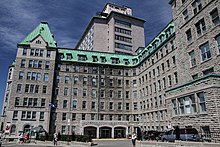
Most jobs in Quebec City are concentrated in public administration, defence, services, commerce, transport and tourism. As the provincial capital, the city benefits from being a regional administrative and services centre: apropos, the provincial government is the largest employer in the city, employing 27,900 people as of 2007.[66]CHUQ (the local hospital network)is the city's largest institutional employer, with more than 10,000 employees in 2007. The unemployment rate in June 2018 was 3.8%, below the national average (6.0%) and the second-lowest of Canada's 34 largest cities, behindPeterborough(2.7%).[67]
Around 10% of jobs are in manufacturing.[68]Principal products include pulp and paper, processed food, metal/wood items, chemicals, electronics and electrical equipment, and printed materials. The city hosts the headquarters of a variety of prominent companies, including: fashion retailerLa Maison Simons,engineering firmsBPRandNorda Stelo;Cominarreal estate investment trust;Beneva,Industrial Alliance,Promutuel, and Union Canadienne in the insurance sector;Beenox,Gearbox Software,Frima Studio,SarbakanandUbisoftin the computer games industry; AeternaZentaris and DiagnoCure in pharmaceuticals; Amalgame, Cossette and Vision 7 in marketing and advertising;Institut National d'Optique (INO),EXFO, OptoSecurity in technology. It is also the domicile of the sole manufactory of the cigarette makerRothmans, Benson & Hedges.
Business districts
[edit]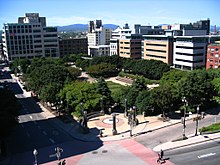
While the traditionalcentral business districtsand their large office buildings are found onParliament Hill(especially for provincial administration) and just below inSaint-Roch(nowadays notable forITand the video game industry), a newer one has emerged in theBoulevard Laurierarea ofSainte-Foy,where a number of accounting andlaw firmshave moved since the 2000s. Other suburban places identified by the city for their potential are the Lebourgneuf area for private offices, as well as Estimauville Street where theGovernment of Canadaalready has many civil servants and where several city officials are expected to move in the 2020s.[50]
Arts and culture
[edit]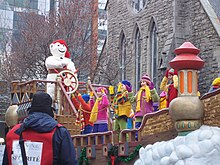
Quebec City is known for itsWinter Carnival,itssummer music festivaland itsSaint-Jean-Baptiste Daycelebrations. TheJardin zoologique du Québec,now closed, reopened in 2002 after extensive repairs before ultimately shutting permanently in 2006. It featured 750 specimens of 300 different species of animals. The zoo specialized in winged fauna and garden themes but also featured several species of mammals. While it emphasized Quebec's indigenous fauna, one of its main attractions was the Indo-Australian greenhouse, which initially cost $14 million to build.[69]It featured fauna and flora from regions surrounding theIndian Ocean.[70]
Parc Aquarium du Québec,which reopened in 2002 on a site overlooking theSaint Lawrence River,features more than 10,000 specimens of mammals, reptiles, fish and other aquaticfauna of North Americaand theArctic.Polar bearsand various species ofsealsof the Arctic sector and the "Large Ocean", a large basin offering visitors a view from underneath, make up part of the aquarium's main attractions.
Québec City has a number of historic sites, art galleries and museums, includingCitadelle of Quebec,Musée national des beaux-arts du Québec,Ursulines of Quebec,andMusée de la civilisation.

Other tourist attractions includeMontmorency Falls,and, just outside the city limits, theBasilica of Sainte-Anne-de-Beaupré,theMont-Sainte-Anneski resort, and theIce Hotel.
Attractions
[edit]
Given the mass ofCap Diamantand the presence ofla Citadelleatop it, overlooking the waters of the St. Lawrence River,Charles Dickensdescribed Quebec City as the "GibraltarofNorth America".[71]
Architecture
[edit]
Much of the city's notable traditional architecture is located inVieux-Québec(Old Quebec), within and below thefortifications.This area has a distinct European feel with its stone buildings and winding streets lined with shops and restaurants. Porte Saint-Louis and Porte Saint-Jean are the main gates through the walls from the modern section of downtown; the Kent Gate was a gift to the province fromQueen Victoriaand the foundation stone was laid by the Queen's daughter,Princess Louise, Marchioness of Lorne,on 11 June 1879.[72]West of the walls are theParliament Hillarea, and to the south thePlains of Abraham.
The upper and lower town are linked by numerous stairs such as theEscalier « casse-cou »( "breakneck stairway" ) or theOld Quebec Funicularon the historicRue du Petit-Champlain,where many small boutiques are found. A small town square nearby, the Place Royale, now surrounded by picturesque stone buildings, is the site ofChamplain's founding of the city in 1608. On it is theNotre-Dame-des-Victoireschurch. TheMusée de la Civilisationis located nearby by the river.



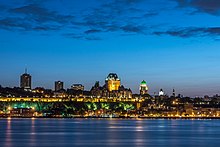
Along with concrete high-rises such asÉdifice Marie-GuyartandLe Concordeon parliament hill (seeList of tallest buildings in Quebec City), the city's skyline is dominated by the massiveChâteau Frontenachotel, perched on top of Cap-Diamant. It was designed by architectBruce Price,as one of a series of"château" style hotelsbuilt for theCanadian Pacific Railwaycompany. The railway company sought to encourage luxury tourism and bring wealthy travellers to its trains. Alongside the Château Frontenac is theTerrasse Dufferin,a walkway along the edge of the cliff, offering views of the Saint Lawrence River. The terrace leads toward the nearbyPlains of Abraham,site of the battle in which the British took Quebec from France, and theCitadelle of Quebec,aCanadian Forcesinstallation and thefederal vice-regal secondary residence.TheParliament Building,the meeting place of theParliament of Quebec,is also near theCitadelle.
Near the Château Frontenac isNotre-Dame de Québec Cathedral,mother church of theRoman Catholic Archdiocese of Quebec.It is the first church in theNew Worldto be raised to abasilicaand is theprimatialchurch of Canada. There are 37National Historic Sites of Canadain Quebec City and its enclaves.[74]
Parks
[edit]One of the most notable isThe Battlefields Park,which is home to 50 historical artillery pieces and thePlains of Abraham.The park offers views of the St. Lawrence River and has multiple historical structures and statues like theJoan of Arcon Horsebackand a couple ofMartello Towers.[75]Historically this was the site of theBattle of the Plains of Abraham(1759), a decisive British victory in theSeven Years' Warwhich ended French rule in what would become Canada, and the laterBattle of Quebec (1775)during theAmerican Revolutionary War,where the British were able to hold onto its last stronghold in the Northern extent of its North American territory.
Other large and centrally located parks areParc Victoria,ParcMaizeretsandCartier-Brébeuf National Historic Site. Quebec City's largest park is theParc Chauveau,which is crossed by the suburban section of the city-wideSaint-Charles Riverand is thus also part of the 31 km (19 mi) long Saint-Charles River'slinear park.At Chauveau, activities such ascanoeing,fishing andcross-country skiingare offered depending on the season, in addition to an interior soccer stadium.[76]Among others, there is also the beach of Beauport Bay, as well as the Marais du Nord (north-endmarshland).
Quebec is the only large city in Canada along withHalifaxlacking a publicgreenhouse.Nonetheless, outside areas known for their publicgardensorlandscapinginclude:[77]
- The linear park namedPromenade Samuel-De Champlainthat stretches 4.6 km (2.9 mi) alongside the Saint Lawrence River, fromPierre Laporte Bridgeto Sillery's east-end. Its bicycle and pedestrian paths then continues to Old Quebec and then along the Saint-Charles River.[78]Just like the beach at Beauport Bay, the construction of thePromenadewas funded by provincial and federal governments to celebrate the400th anniversary of Quebec Cityin 2008.
- Government House (Quebec),slightly west of the Plains of Abraham inSillery,and known for itsnatural landscapingas well as traditional gardens, such as those surrounding the historicalVilla Bagatelle.The historical significance of the park also lies in the former presence of the viceregalGovernment House of Quebec(1845–1966).
- TheDomaine de Maizerets,where are found anarboretumand anobservation tower,not far from the Saint Lawrence River and Beauport Bay.
- Domaine Cataraquiin Sillery.
- TheRoger-Van den Hende Botanical GardenofUniversité Laval.
Sports
[edit]Quebec City has hosted a number of recent sporting events, as well as being shortlisted for the2002 Winter Olympics city selection.TheSpecial Olympics Canada National Winter Gameswas held in the city from 26 February to 1 March 2008.[79]Quebec City co-hosted withHalifax,Nova Scotia, the2008 IIHF World Championship.Regular sporting events held in the city include theCoupe Banque Nationale,aWomen's Tennis Associationtournament;Crashed Ice,an extreme downhill skating race;Quebec International Pee-Wee Hockey Tournament,aminor hockeytournament; and the Tour de Québec International cycling stage race.[80]In December 2011, Quebec City hosted theISU Grand Prix of Figure Skating Finalat the Pavillon de la Jeunesse at ExpoCité.

The city currently has one professional team, the baseball teamCapitales de Québec,which plays in theFrontier Leaguein downtown'sStade Canac.The team was established in 1999 and originally played in theNorthern League.It has nine league titles, won in 2006, 2009, 2010, 2011, 2012, 2013, 2017, 2022 and 2023. A professional basketball team, theQuebec Kebs,played inNational Basketball League of Canadain 2011 but folded before the 2012 season, and a semi-professionalsoccerteam, theDynamo de Québec,played in thePremière ligue de soccer du Québec,until 2019.
The city had a professional ice hockey team, theQuebec Nordiques,which played in theWorld Hockey Association(WHA) from 1972 to 1979 and theNational Hockey League(NHL) from 1979 to 1995, maintaining a strong rivalry with theMontreal Canadiens.Due to a disadvantageous exchange rate with respect to the US dollar, the team moved toDenver, Colorado,in 1995, becoming theColorado Avalanche.A lower-tier team, theQuebec Rafales,played in the professionalInternational Hockey Leaguefrom 1996 to 1998.

TheVideotron Centrewas built with the hope of getting anNHLfranchise (relocation or expansion) in Quebec City.[81]The project was funded regardless of whether an NHL team arrives.[82]It is also hoped that the arena can help Quebec City win a futureWinter Olympicsgames bid.[83]It has now replaced theColisée de Québecas the main multifunctional arena in Quebec City.
Other teams include theQuebec Rempartsin major junior hockey (QMJHL), Université Laval varsity teamRouge & Or,theQuebec City Monarks,andQuebec City Rebellesof La Ligue de Football de Québec; the Alouettes de Charlesbourg of theLigue de Baseball Junior Élite du Québec;the women's hockey team Quebec Phoenix of theCanadian Women's Hockey League;and soccer clubQuebec Arsenalof theW-League.
Quebec City holds the CoopFIS Cross-Country World Cup.This is askievent that welcomes the best of that sport.[84]
Government
[edit]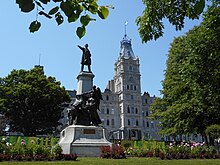
Since the 1960s,centre-rightparties such asUnion Nationale,Crédit social,Conservative Party of Canada(CPC),Action démocratique du QuébecandCoalition Avenir Québec(CAQ) have been more popular in the Quebec City region than elsewhere in the province.[85]After thefederal election of 2006,six of the ten conservative ridings of the province were found in its metropolitan area (where the CPC garnered 39% of the vote, against 25% at the provincial scale)[86]and in the city proper, the CPC won three of the four seats that existed at that time (theriding of Quebecwent to theBloc).[87]Along with the city's lesser support forQuebec sovereignty,this led political pundits to speculate about a "Quebec City mystery".[88]
Various lines of thought were offered, including the popularity of thetalk radiostationsCHOIandFM93expressingfiscally conservativeand non-politically correctopinions.[89]Over the years, this genre has been qualified by its detractors asradio poubelle(fr) ( "trash radio" ) and hosts likeJeff FillionandAndré Arthurlikened toshock jocks.[90]Also, compared to the rest of the province, people of the area may favour harsher criminal sentences, and lower-class households may share political views more in line with those earning more. The reasons for this remain unclear.[85]Another researcher put forward the historical factors that led to Montreal surpassing Quebec as the metropolis ofBritish North Americain the early 19th century. According to this theory, its permanent status of "second city" (albeit the capital) engendered feelings of "repressed jealousy".[91]
The "mystery" was relativized following the2011 federal election.All five ridings within the city were won by the leftistNew Democratic Party,in the so-called "orange wave" that temporarily swept the province. Nonetheless, five of the six seats won by the Conservatives in the province were found in the greater Quebec City area.[92]At the2018 provincial election,the leftist partyQuébec solidairemanaged to win two districts,TaschereauandJean-Lesage,the most densely populated in town, but the centre-right CAQ, as it swept the province, won six of the nine districts encompassing the city, and 15 of the 18 in the administrative regions ofCapitale-NationaleandChaudière-Appalaches(south shore of the city).
| Year | Liberal | Conservative | Bloc Québécois | New Democratic | Green | ||||||
|---|---|---|---|---|---|---|---|---|---|---|---|
| 2021 | 27% | 76,734 | 34% | 96,875 | 27% | 75,949 | 8% | 23,129 | 2% | 5,715 | |
| 2019 | 28% | 82,742 | 29% | 84,656 | 28% | 82,950 | 9% | 25,969 | 4% | 11,789 | |
| Year | CAQ | Liberal | QC solidaire | Parti Québécois | |||||
|---|---|---|---|---|---|---|---|---|---|
| 2018 | 41% | 118,468 | 22% | 65,462 | 19% | 55,126 | 12% | 34,079 | |
| 2014 | 32% | 95,770 | 39% | 118,564 | 7% | 21,123 | 19% | 57,481 | |
Municipal government
[edit]
Quebec City is governed by amayor–council government,which includes the 21single-member districtsof the legislativeQuebec City Counciland the separately electedmayor.Thecouncilorsare elected byfirst-past-the-post votingwhile the mayor is elected by the cityat-large.Both usually belong topolitical partiesand are elected at the same time every 4 years. The mayor is anex officio memberof the council but is not its president and has no vote. The current one isBruno Marchand,elected in2021.
Each of the city's six boroughs has a council composed of 3 to 5 of the aforementioned councillors, depending on the size of its population. It has jurisdiction with matters such as local road maintenance, leisure,waste collection,and small grants for community projects and others, but cannot tax or borrow money.[95]The boroughs are further divided into35 neighbourhoods,which also have councils devoted topublic consultations,each led by 11 citizens. Their geographical limits may be distinct from those of the city's 21 electoral districts, and councillors also sit at their neighbourhood councils as non-voting ex officio members.[96]
Public safety
[edit]The city is protected byService de police de la Ville de QuébecandService de protection contre les incendies de Québec(fire dept.) Thecensus metropolitan area(CMA) of Quebec City has one of the lowest crime rates in Canada, with 3,193 per 100,000 persons in 2017, only behindToronto's CMA(3,115).[97]Exceptionally, nohomicide(defined as a criminal death, deliberate or not) was reported in 2007.[98]Still, eight homicides occurred the following year.[99]
On 29 January 2017, a university studentshot and killed six peoplewith another 17 injured in a mass shooting at theQuebec Islamic Cultural Centre.[100]Even after accounting for this event, the CMA of Quebec had the second lowest Crime Severity Index in the country in 2017, at 48.5, after that ofBarrie(45.3).[101]For the year 2017, the number of reported incidents investigated ashate crimesby the city police increased from 57 to 71, and for those specifically targeting Muslims from 21 to 42.[102]The overall rate of reported hate crimes was thus 7.1 per 100,000 population — higher than the national average (3.9) and in Montreal (4.7) but lower than rates inHamilton,OttawaandThunder Bay.[103]
There were twofirst-degree murdersin 2018, seven in 2017 (six of which were due to the mosque shooting), one in 2016, two in 2015 and three in 2014.[104][105][106]
On 1 November 2020, the Quebec City police arrested a man dressed in medieval costume and armed with a Japanese sword. Carl Girouard, the arrestee, reportedly killed 2 people and hospitalized 5 others.[107]
Infrastructure
[edit]This sectionneeds additional citations forverification.(April 2016) |
Roads
[edit]Two bridges (theQuebec BridgeandPierre Laporte Bridge) and a ferry service connect the city withLévisand its suburbs along the south shore of theSaint Lawrence River.TheOrleans Island Bridgelinks Quebec City with pastoralOrleans Island.

Quebec City is an important hub in the province'sautoroutesystem, as well as boasting one of the highest "expressway lane kilometres per 1000 persons" in the country (1.10 km), behindCalgary(1.74),Hamilton(1.61) andEdmonton(1.24).[108]Autoroute 40connects the region withMontrealandOttawato the west andSainte-Anne-de-Beaupréand theCharlevoixregion to the east.Autoroute 20parallels the south shore of the St. Lawrence River, linking Quebec City with Montreal andTorontoto the west andRivière-du-Loup,Rimouski,and theMaritime Provincesto the east.Autoroute 73provides a north–south link through the metropolitan area, linking it withSaint-Georges,theBeauceregion, and Maine to the south andSaguenayand theLac-Saint-Jeanregion to the north.
Within the metropolitan region, Autoroutes 40, 73, and several spur routes link the city centre with its suburbs.
Autoroute 573 (Autoroute Henri-IV)connects the city withCFB Valcartier.Autoroute 740 (Autoroute Robert-Bourassa)serves as a north–south inner belt.Autoroute 440comprises two separate autoroutes to the west and east of the urban core. Originally meant to be connected by a tunnel under the city centre, the two sections are separated by a 6 km (3.7 mi) gap. There are no current plans to connect them. The western section (Autoroute Charest) connects Autoroutes 40 and 73 with Boulevard Charest (a main east–west avenue) while the eastern section (Autoroute Dufferin-Montmorency) links the city centre withBeauportandMontmorency Falls.
Public transport
[edit]

TheRéseau de transport de la Capitale(RTC) is responsible for public transport in the region. The RTC operates a fleet of buses and has recently implemented articulated buses. The RTC is studying the return of atramwaysystem to help ease overcrowding on its busiest lines as well as attract new users to public transit. The two billion dollar revitalization project needs approval from higher levels of government since the city does not have the financial resources to fund such an ambitious project on its own. As of 2022, the project named Quebec City Tramway is under development.[109][110][111]
Rail transport is operated byVia Railat theGare du Palais('Palace Station'). The station is the eastern terminus of the railway's mainQuebec City-Windsor Corridor.An inter-city bus station, with connections to the provincial long-distance bus network, is adjacent to the train station, and is used by operators such asOrleans ExpressandIntercar.
Air and sea
[edit]Quebec City is served byJean Lesage International Airport,located 13 km (8.1 mi) west of the city centre.
ThePort of Quebecis a seaport on the St. Lawrence with facilities in the first, fifth and sixth boroughs.[112]
Education
[edit]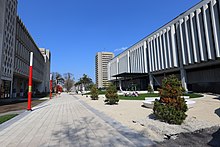
TheUniversité Laval(Laval University) is in the southwestern part of the city, in the borough ofSainte-Foy,except for its school of architecture, which is at the "Vieux-Séminaire"building in Old Quebec.
TheUniversité du Québec systemadministrative headquarters and some of its specialized schools (École nationale d'administration publique,Institut national de la recherche scientifiqueandTélé-université) are in theSaint-Roch neighbourhood.
CEGEPsof Quebec city areCollège François-Xavier-Garneau,Cégep Limoilou,Cégep de Sainte-FoyandChamplain College St. Lawrence,as well as private and specialized post-secondary institutions such as Campus Notre-Dame-de-Foy,Collège Mérici,Collège Bart,Collège CDI,Collège O'Sullivan and Collège Multihexa.
Threeschool boards,includingCommission scolaire de la Capitale,operate secular francophone schools, andCentral Quebec School Boardoperates the few existing anglophone ones. Until 1998Commission des écoles catholiques de Québecoperated public Catholic schools of all languages.
Quebec City has the oldest educational institution for women in North America, led by theUrsulines of Quebec,which is now a private elementary school.
Sister cities
[edit]Quebec City istwinnedwith:
It has formal agreements with other cities although they are not active as of 2012. These includeSaint PetersburginRussia,Guanajuato CityinMexico,HuếinVietnam,Paris,Xi'aninChina,andLiègeandNamurinfrancophone Belgium.[113]
Notable people
[edit]See also
[edit]References
[edit]Informational notes
- ^TheAlgonquin languageis a distinct language of theAlgonquian language family,and is not a misspelling.
- ^Although snow is measured in cm the melted snow (water equivalent) is measured in mm and added to the rainfall to obtain the total precipitation. An approximation of the water equivalent can be made by dividing the snow depth by ten. Thus 1 cm (0.4 in) of snow is equivalent to approximately 1 mm (0.04 in) of water. Seesnow gauge,Rainfall, Snowfall, and PrecipitationArchived28 December 2012 at theWayback MachineandMANOBS 7th Edition Amendment 17[dead link]
- ^Based on station coordinates provided by Environment and Climate Change Canada, climate data was recorded in the area ofOld Quebecfrom August 1875 to February 1959, and atQuébec City Jean Lesage International Airportfrom March 1943 to present.
Citations
- ^Marceau, Stéphane G.; Rémillard, François (2002).Ville de Québec(in French) (4th ed.). Montreal: Guides de voyage Ulysse. p. 14.ISBN2-89464-510-4.
- ^"Quebec City".Geographical Names Data Base.Natural Resources Canada.
- ^"Banque de noms de lieux du Québec:Reference number 51718 ".toponymie.gouv.qc.ca(in French).Commission de toponymie du Québec.
- ^"Incorporation de Québec".23 October 2007.Archivedfrom the original on 28 October 2021.Retrieved11 March2018.
- ^ab"Répertoire des municipalités:Geographic code 23027 ".www.mamh.gouv.qc.ca(in French). Ministère des Affaires municipales et de l'Habitation.
- ^ab"Population and Dwelling Count Highlight Tables, 2016 Census".Government of Canada,Statistics Canada.8 February 2017.Archivedfrom the original on 28 October 2021.Retrieved15 February2017.
- ^ab"Population and Dwelling Count Highlight Tables, 2021 Census".Government of Canada, Statistics Canada.
- ^Vallières, Marc."Québec City".Archived fromthe originalon 22 May 2012.Retrieved17 June2012.
- ^"Gross domestic product (GDP) at basic prices, by census metropolitan area (CMA)".6 December 2023.
- ^"Quebec City (Code 421) Census Profile".2011 census.Government of Canada -Statistics Canada.
- ^"Quebec".Oxford English Dictionary(Online ed.).Oxford University Press.(Subscription orparticipating institution membershiprequired.)
- ^Government of Canada, Natural Resources Canada."Place names – Québec".www4.rncan.gc.ca.Archivedfrom the original on 28 October 2021.Retrieved31 March2019.
- ^"Québec, Ville [Census subdivision], Quebec and Québec, Territoire équivalent [Census division], Quebec".Census 2016.Statistics Canada. 8 February 2017.Archivedfrom the original on 28 October 2021.Retrieved3 March2017.
- ^"Population and Dwelling Count Highlight Tables, 2016 Census".www12.statcan.gc.ca.Government of Canada, Statistics Canada. 8 February 2017.Archivedfrom the original on 23 September 2018.Retrieved15 February2017.
- ^"Historic District of Old QuébecArchived28 June 2011 at theWayback Machine".World Heritage;UNESCO.Retrieved 12 January 2009.
- ^"Old Quebec City, Seven Wonders of Canada".cbc.ca.Archivedfrom the original on 7 February 2008.Retrieved12 February2008.
- ^Government of Canada, Public Services and Procurement Canada (28 February 2020)."Québec, City of Québec, Quebec City – Writing Tips Plus – Writing Tools – Resources of the Language Portal of Canada – Canada.ca".Writing Tips Plus.Retrieved20 May2022.
- ^"Québec, City of Québec, Quebec City".Public Works and Government Services Canada. 2016.Archivedfrom the original on 14 September 2016.Retrieved29 October2016.
- ^"Names (geographical)".Public Service Commission of Canada.Archivedfrom the original on 21 November 2016.Retrieved29 October2016.
- ^Government of Canada (8 October 2009)."Geographical Names".The Canadian Style.Archivedfrom the original on 30 October 2016.Retrieved29 October2016.
- ^"Faut-il traduire les toponymes?".Commission de toponymie.26 November 2020.Retrieved20 May2022.
- ^"Québec en quelques mots".Immigrant Québec(in Canadian French). 22 October 2021.Retrieved20 May2022.
- ^"CBC.CA – Seven Wonders of Canada – Your Nominations – Old Quebec City, Quebec".www.cbc.ca.Archivedfrom the original on 1 April 2019.Retrieved31 March2019.
- ^"Fort Charlesbourg Royal National Historic Site of Canada".www.historicplaces.ca.Parks Canada.Archivedfrom the original on 28 October 2021.Retrieved6 October2018.
- ^"View of Quebec, Capital of Canada".World Digital Library.Archivedfrom the original on 28 October 2021.Retrieved11 February2013.
- ^Moss, William (2 December 2017).The Recent Archaeology of the Early Modern Period in Quebec City: 2009.Routledge. p. 334.ISBN9781351193337.Archivedfrom the original on 28 October 2021.Retrieved30 June2019.
- ^abc"KIRKE, SIR DAVID, adventurer, trader, colonizer, leader of the expedition that captured Quebec in 1629, and later governor of Newfoundland"Archived17 September 2020 at theWayback Machine,Dictionary of Canadian Biography Online
- ^Morison, Samuel Eliot (1972).The Oxford history of the American people.New York: Mentor. p. 150.ISBN0-451-62600-1.OCLC7384608.
- ^"George R, Proclamation, 7 October 1763 (Royal Proclamation)".PrimaryDocuments.ca.7 October 1763.Archivedfrom the original on 1 April 2019.Retrieved31 March2019.
- ^Cartier, Gwenaël (2009)."Québec 1608–2008: 400 ans de statistiques démographiques tirées des recensements".Cahiers québécois de démographie(in French).37:143.doi:10.7202/029642ar.Archivedfrom the original on 29 July 2018.Retrieved29 July2018.
- ^"Ville de Québec – Québec City, Fortress and Port (1756–1867)".Ville de Québec.Archivedfrom the original on 28 October 2021.Retrieved31 March2019.
- ^Clapperton, Nina (18 November 2021)."13 Canada Capital Cities".Nina Out and About.Retrieved10 April2022.
- ^"Canadian Military Heritage Volume 2 (1755–1871). Canadian Militia Unpopular with Francophones".Canadian Military History Gateway.Department of National Defence. June 2017.Archivedfrom the original on 12 October 2018.Retrieved6 October2018.
- ^Richard Preston 'Canada's RMC: A History of the Royal Military College of Canada' published by the RMC Club by U of Toronto Press.
- ^Geological Survey of Canada (1999).The 1988 Saguenay Earthquake – a Site Visit Report.p. 63.
- ^Stelter, Gilbert (1982).Shaping the Urban Landscape: Aspects of the Canadian City-Building Process.McGill Queen University Press.ISBN9780773584860.Archivedfrom the original on 28 October 2021.Retrieved6 October2018.
- ^Décret concernant la révision des limites des régions administratives du Québec, R.Q. c. D-11, r.2, made pursuant to the Territorial Division Act, R.S.Q. c. D-11
- ^"Québec Portal > Portrait of Québec > Administrative Regions > Regions".Archivedfrom the original on 1 February 2009.Retrieved13 May2009.
- ^"An Act respecting the National capital commission, R.S.Q. c. C-33.1".CanLII. 4 May 2009.Archivedfrom the original on 6 May 2010.Retrieved13 May2009.
- ^Peel, M. C.; Finlayson, B. L.; McMahon, T. A. (2007)."Updated world map of the Köppen–Geiger climate classification"(PDF).Hydrol. Earth Syst. Sci.11(5): 1633–1644.Bibcode:2007HESS...11.1633P.doi:10.5194/hess-11-1633-2007.ISSN1027-5606.Archived(PDF)from the original on 3 February 2012.Retrieved10 February2013.
- ^"Daily Data Report for July 1953".Canadian Climate Data.Environment Canada.31 October 2011.Archivedfrom the original on 16 August 2016.Retrieved8 July2016.
- ^"Daily Data Report for January 1890".Canadian Climate Data.Environment Canada.31 October 2011.Archivedfrom the original on 16 August 2016.Retrieved8 July2016.
- ^"Daily Data Report for January 2015".Canadian Climate Data.Environment Canada.31 October 2011.Archivedfrom the original on 16 August 2016.Retrieved8 July2016.
- ^"Quebec/Jean Lesage INT'L A, Quebec".Canadian Climate Normals 1981–2010.Environment and Climate Change Canada.Archivedfrom the original on 9 May 2014.Retrieved8 May2014.
- ^"QUEBEC/JEAN LESAGE INTL".Canadian Climate Data.Environment and Climate Change Canada.Archivedfrom the original on 17 August 2016.Retrieved28 March2016.
- ^"Quebec".Canadian Climate Data.Environment and Climate Change Canada.Archivedfrom the original on 17 August 2016.Retrieved28 March2016.
- ^Yu Media Group d.o.o."Quebec city, Canada – Detailed climate information and monthly weather forecast".Weather Atlas.Archivedfrom the original on 6 July 2019.Retrieved6 July2019.
- ^"Nouveau découpage des arrondissements - Modifications territoriales".www.ville.quebec.qc.ca(in French). Ville de Québec. Archived fromthe originalon 25 September 2009.
- ^Rainville, Candide; Service de l'ingénierie. Division de l'arpentage et de la cartographie. Ville de Québec (10 January 2011)."Les arrondissements et leurs quartiers"[The boroughs and their quarters](PDF)(Map).clubdimension.org(in French).Archived(PDF)from the original on 5 November 2019.Retrieved5 November2019.
- ^ab"Où sera le centre-ville de Québec dans le futur?".Radio-Canada.ca(in Canadian French). 7 October 2018.Archivedfrom the original on 9 October 2018.Retrieved9 October2018.
- ^abStatistics Canada:1871,1881, 1891, 1901,1911,1921,1931,1941,1951,1956, 1961, 1966, 1971, 1976, 1981, 1986,1991,1996,2001,2006,2011,2016,2021census
- ^"Évolution démographique des 10 principales villes du Québec (Sur la base de 2006) selon leur limites territoriales actuelles1, Recensements du Canada de 1871 à 2006".www.stat.gouv.qc.ca.Archived fromthe originalon 6 October 2013.Retrieved19 October2022.
- ^"Population and dwelling counts: Canada, provinces and territories, and census subdivisions (municipalities), Quebec".Statistics Canada.9 February 2022.Retrieved29 August2022.
- ^"Population and Dwelling Count Highlight Tables, 2016 Census".www12.statcan.gc.ca.Government of Canada, Statistics Canada. 8 February 2017.Archivedfrom the original on 10 February 2017.Retrieved9 February2017.
- ^Government of Canada, Statistics Canada (8 February 2017)."Census Profile, 2016 Census – Québec, Ville [Census subdivision], Quebec and Canada [Country]".www12.statcan.gc.ca.Archivedfrom the original on 28 October 2021.Retrieved16 July2019.
- ^"Census Profile, 2021 - Québec, Ville".Statistics Canada.9 February 2022.
- ^"Census Profile, 2021 - Canada [Country]".Statistics Canada.9 February 2022.
- ^abcdGovernment of Canada, Statistics Canada (26 October 2022)."Census Profile, 2021 Census of Population".www12.statcan.gc.ca.Retrieved9 November2022.
- ^Government of Canada, Statistics Canada (27 October 2021)."Census Profile, 2016 Census".www12.statcan.gc.ca.Retrieved12 January2023.
- ^Government of Canada, Statistics Canada (27 November 2015)."NHS Profile".www12.statcan.gc.ca.Retrieved12 January2023.
- ^Government of Canada, Statistics Canada (20 August 2019)."2006 Community Profiles".www12.statcan.gc.ca.Retrieved12 January2023.
- ^Government of Canada, Statistics Canada (2 July 2019)."2001 Community Profiles".www12.statcan.gc.ca.Retrieved12 January2023.
- ^Morrin Centre."Anglos in Québec".Literary and Historical Society of Quebec. Archived fromthe originalon 6 March 2012.Retrieved15 March2007.
- ^Blair, Louisa. The Anglos: The Hidden Face of Quebec City. Volume 1: 1608–1850; Volume 2: Since 1850. Québec: Commission de la capitale nationale du Québec & Éditions Sylvain Harvey, 2005.
- ^"Voice of English-speaking Québec: A Portrait of the English-speaking Community in Quebec".Voice of English-speaking Québec. 2007. Archived fromthe originalon 29 September 2007.Retrieved15 March2007.
- ^"Canada's largest employers by city, 2007: Quebec City".University of Western Ontario.Archived fromthe originalon 18 April 2010.
- ^"Here's a quick glance at unemployment rates for June, by Canadian city".Financial Post.6 July 2018.Archivedfrom the original on 9 October 2018.Retrieved9 October2018.
- ^"Québec City: Economy, transportation, and labour force"Archived25 September 2017 at theWayback Machine.The Canadian Encyclopedia.Historical Foundation of Canada, 2008. Retrieved 12 January 2009.
- ^"Abandoned zoo greenhouse faces demolition".QCNA EN.23 November 2021.Retrieved28 September2022.
- ^"2022 - The greenhouse of the former Quebec zoo will indeed be demolished, confirms the City - Actual News Magazine"(in Turkish). 9 December 2021.Retrieved28 September2022.
- ^Marsh, James A. (30 October 2014),"Quebec City in the War of 1812",The Canadian Encyclopedia,Historica Canada,retrieved26 March2023
- ^Hubbard, R.H. (1977).Rideau Hall.McGill-Queen's University Press. p.49.ISBN978-0-7735-0310-6.
- ^Simard, Luc; Émond, Chantale (1994).Du cap au rivage: promenades dans les rues de Québec(in French). Québec (Québec). Québec: Ville de Québec.ISBN978-2-92-086077-3.OCLC31779784.
- ^The 37 sites in Quebec City are listed in theDirectory of Federal Heritage Designationsas being located in Québec and the following boroughs/enclaves: Beauport, Cap-Rouge, Notre-Dame-des-Anges, Sainte-Foy and Wendake.
- ^"Ville de Québec – Parks and Gardens".www.ville.quebec.qc.ca.Archived fromthe originalon 14 November 2016.Retrieved14 November2016.
- ^"Le Parc Chauveau: la nature à ma portée!"(PDF)(in French). Ville de Québec.Archived(PDF)from the original on 4 March 2016.Retrieved6 October2018.
- ^Hogdson, Larry (8 September 2018)."Québec, toujours un désert botanique?".Le Soleil(in Canadian French).Archivedfrom the original on 6 October 2018.Retrieved6 October2018.
- ^Québec, Office du tourisme de."Promenade Samuel-De Champlain".Official Web Site – Québec City Tourism.Archivedfrom the original on 6 October 2018.Retrieved6 October2018.
- ^"History of Major Special Olympics Canada (SOC) Events"(PDF).Special Olympics Canada. 29 January 2007. Archived fromthe original(PDF)on 6 July 2011.Retrieved14 July2011.
- ^"Here comes the 4th Tour de Québec!".tourdequebec.com.Archivedfrom the original on 9 March 2012.Retrieved14 July2011.
- ^Karine Gagnon, Qmi Agency (1 March 2011)."Quebecor joins arena plan, eyes NHL team | Hockey | Sports".Toronto Sun.Archivedfrom the original on 1 October 2012.Retrieved2 January2012.
- ^McParland, Kelly (2 March 2011)."The Quebec gravy train chugs off without Ottawa on board for once".National Post.Archivedfrom the original on 11 March 2011.
- ^"Quebec City plans $400 million arena to attract NHL team, Winter Olympics — ESPN".ESPN.16 October 2009.Archivedfrom the original on 29 June 2011.Retrieved2 January2012.
- ^"Quebec city FIS Cross-Country World Cup 2019".Quebec City FIS Cross-Country World Cup.Archivedfrom the original on 6 August 2020.Retrieved30 March2020.
- ^abDuval, Alexandre (11 August 2017)."Politique: un chercheur perce une partie du" mystère Québec "".Radio-Canada.ca(in Canadian French).Archivedfrom the original on 9 October 2018.Retrieved8 October2018.
- ^Daoust, Jean-François (15 August 2017)."Le mystère de Québec: les moins bien nantis rejettent la gauche".Le Devoir(in French).Archivedfrom the original on 9 October 2018.Retrieved8 October2018.
- ^Himelfarb, Jordan (10 October 2018)."The Bloc's Quebec City fortress".The Globe and Mail.Archivedfrom the original on 28 October 2021.Retrieved8 October2018.
- ^Peritz, Ingrid (31 August 2012)."Seeking clues to Quebec City's ballot box mystery".The Globe and Mail.Archivedfrom the original on 1 September 2012.Retrieved8 October2018.
- ^Castonguay, Alec (31 August 2012)."Le faux mystère de Québec".L’actualité(in Canadian French).Archivedfrom the original on 10 October 2018.Retrieved8 October2018.
- ^Bilefsky, Dan (18 August 2018)."Quebec's 'Trash Radio' Host Fires Up Outrage, and Big Ratings".The New York Times.Archivedfrom the original on 9 October 2018.Retrieved8 October2018.
- ^Lachance, Nicolas (20 December 2015)."Il perce (enfin) le mystère Québec".Le Journal de Québec(in Canadian French).Archivedfrom the original on 10 October 2018.Retrieved8 October2018.
- ^Séguin, Rheal (2 May 2011)."Quebec City gives NDP control over the region".The Globe and Mail.Archivedfrom the original on 28 October 2021.Retrieved8 October2018.
- ^"Official Voting Results Raw Data (poll by poll results in Quebec City)".Elections Canada. 7 April 2022.Retrieved28 February2023.
- ^"Official Voting Results by polling station (poll by poll results in Quebec City)".Elections Québec.Retrieved28 February2023.
- ^"Conseils d'arrondissement".Ville de Québec.Archived fromthe originalon 6 October 2014.
- ^"Conseils de quartier".Ville de Québec.Archived fromthe originalon 8 March 2017.
- ^"2017 Police-reported Crime Severity Index and crime rate, by census metropolitan area".Statistics Canada.23 July 2018.Archivedfrom the original on 21 October 2018.Retrieved9 October2018.
- ^White, Marianne (28 December 2007)."Quebec City closing in on a year without murder".Nationalpost.com.Retrieved14 July2011.
- ^Neron, Jean-François (2010)."Bas taux d'homicide: fiche impressionnante pour Québec"(in French). Le Soleil.Archivedfrom the original on 29 July 2018.Retrieved29 July2018.
- ^"Suspect in Quebec mosque terror attack was of Moroccan origin, reports show".Fox News.30 January 2017.Archivedfrom the original on 30 January 2017.Retrieved30 January2017.
- ^"Police-reported crime statistics in Canada, 2017".Statistics Canada.23 July 2018.Archivedfrom the original on 21 October 2018.Retrieved9 October2018.
- ^"Hate crimes targeting Muslims doubled in 2017, says Quebec City police chief".CBC News.Archivedfrom the original on 21 October 2018.Retrieved3 September2018.
- ^"Reported hate crimes jumped in Quebec City in year prior to mosque shooting".CBC News.29 November 2018.Archivedfrom the original on 16 December 2018.Retrieved3 September2018.
- ^"Rapport annuel 2018"(PDF).Service de Police de la Ville de Québec(in French). p. 14.Archived(PDF)from the original on 28 October 2021.Retrieved22 June2019.
- ^"Rapport annuel 2017"(PDF).Service de Police de la Ville de Québec(in French). p. 12.Archived(PDF)from the original on 21 December 2018.Retrieved8 December2018.
- ^"Rapport annuel 2016"(PDF).Service de Police de la Ville de Québec(in French). p. 20.Archived(PDF)from the original on 13 February 2018.Retrieved8 December2018.
- ^Bilefsky, Dan (November 2020)."Halloween Stabbing Attack in Quebec City Leaves 2 Dead".The New York Times.Archivedfrom the original on 4 January 2021.Retrieved1 November2020.
- ^"Projet de prolongement de l'axe du Vallon"(PDF).BAPE(in French). 2004. p. 2. Archived fromthe original(PDF)on 29 March 2018.Retrieved21 March2017.
- ^"Quebec City tramway finally gets green light as province gives unconditional approval".CBC. 6 April 2022.
- ^"We represent the interests of rail and bus passengers and advocate for public transport services in Canada".28 April 2021.
- ^"Quebec city Tram Will Be A Reality: Rail for the Valley".6 April 2022.
- ^"Port of Quebec".Archived fromthe originalon 3 February 2012.Retrieved24 June2009.
- ^"Québec fait le ménage dans ses jumelages".Le Soleil(in French). 7 September 2012. Archived fromthe originalon 21 September 2016.
External links
[edit]- Official website

- Official website of Québec City Tourism
- Focus on Geography Series, 2016 Census— Census subdivision of Québec City fromStatistics Canada
- CBC Digital Archives— CBC Television Special: Preserving Quebec City (1976)
- CBC Digital Archives— Quebec City: 400 Years of History
- Quebec City
- Cities and towns in Quebec
- World Heritage Sites in Canada
- Quebec populated places on the Saint Lawrence River
- Populated places established in 1608
- 1608 establishments in New France
- Former colonial capitals in Canada
- Hudson's Bay Company trading posts
- Port settlements in Quebec
- 1608 in North America
- 1600s in Canada
- 1608 in New France














